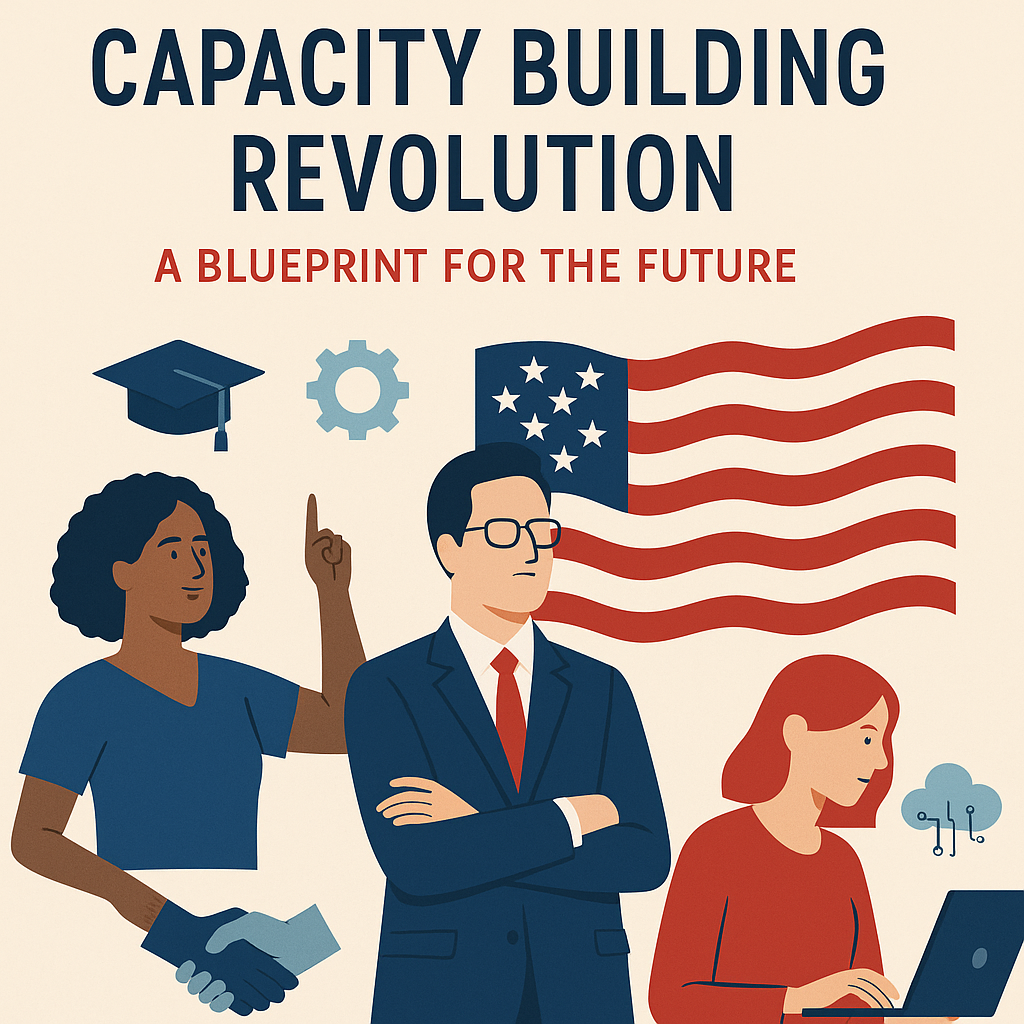Policy Paper
America’s Capacity Building Revolution: A Blueprint for the Future
Executive Summary
In 2025, the United States faces an urgent capacity-building challenge. Rapid technological disruption, political polarization, inequality, and climate change demand not just policy responses but a revolution in skills, institutional resilience, and civic trust. America’s future prosperity depends on transformational leadership that can modernize education, strengthen workforce skills, integrate digital literacy, and ensure inclusivity.
This policy paper outlines the key dimensions of America’s capacity-building revolution, highlights successful models, identifies risks, and provides a blueprint for future leadership that can rebuild the nation’s capabilities for the 21st century.
Table of Contents
-
Introduction: Why America Needs a Capacity Building Revolution
-
Defining Capacity Building in the U.S. Context
-
Drivers of America’s Transformation
-
Case Studies of U.S. Capacity Building Models
-
Traits of Transformational U.S. Leaders
-
Institutional, Cultural, and Technological Enablers
-
Barriers and Risks
-
Policy Recommendations: Blueprint for America
-
Implications for Governance, Business, and Civil Society
-
Conclusion
1. Introduction: Why America Needs a Capacity Building Revolution
The U.S. is facing converging challenges:
-
Trust deficit: Gallup reports only 27% of Americans trust federal government institutions (Gallup, 2024).
-
Technological disruption: AI, automation, and robotics threaten traditional jobs, while creating demand for new skills.
-
Inequality: Persistent racial, gender, and geographic disparities limit access to opportunity (Brookings, 2024).
-
Climate resilience: The U.S. must build capacity for renewable energy, disaster adaptation, and green jobs.
These pressures demand not incremental reform but a capacity building revolution across education, workforce, and governance.
2. Defining Capacity Building in the U.S. Context
In America, capacity building means strengthening:
-
Workforce skills: Digital, AI, cybersecurity, green economy, and health sectors.
-
Institutions: Education systems, public health, disaster preparedness, and civic infrastructure.
-
Social trust & civic engagement: Rebuilding faith in democracy and community resilience.
Transformational leaders in this context must align vision with practice, foster inclusivity, and bridge divides.
3. Drivers of America’s Transformation
-
Digital revolution: AI and data-driven innovation.
-
Green economy transition: Renewable energy, electric vehicles, sustainable infrastructure.
-
Public health security: Lessons from COVID-19 highlight the need for resilient systems.
-
Equity & inclusion: Closing opportunity gaps in education, jobs, and technology access.
-
Global competitiveness: U.S. leadership requires continuous investment in human capital.
4. Case Studies of U.S. Capacity Building Models
Operation Warp Speed (2020–21)
Demonstrated the power of government-private sector collaboration in accelerating vaccine development.
Workforce Innovation and Opportunity Act (WIOA)
Federal funding for retraining programs in advanced manufacturing, IT, and healthcare.
TechHire Initiative
Created pathways for underserved communities to enter digital and tech careers.
Apprenticeships in Clean Energy (California, Michigan)
Public-private partnerships preparing workers for solar, wind, and EV industries.
5. Traits of Transformational U.S. Leaders
-
Visionary yet pragmatic: Linking long-term goals with real solutions.
-
Bridge-builders: Bipartisan and cross-sector collaboration.
-
Digitally fluent: Understanding AI, data, and cybersecurity.
-
Inclusive and equity-oriented: Ensuring women, minorities, and rural communities benefit.
-
Resilient: Capable of guiding institutions through crises.
6. Enablers: Institutional, Cultural, and Technological
-
Strong higher education and community college systems.
-
Federal funding mechanisms for innovation (e.g., CHIPS Act).
-
Private sector leadership in AI and clean energy.
-
Civil society engagement and grassroots organizing.
-
Public-private-philanthropic partnerships for workforce development.
7. Barriers and Risks
-
Polarization and gridlock undermining long-term policy.
-
Unequal access to broadband, digital tools, and quality education.
-
Underinvestment in rural and marginalized communities.
-
Short-termism driven by election cycles and quarterly profits.
-
Brain drain: Talent moving abroad or concentrated in tech hubs.
8. Policy Recommendations: Blueprint for America
-
Expand access to digital skills and AI literacy through public schools, community colleges, and workforce programs.
-
Invest in green capacity building, aligning workforce with climate transition jobs.
-
Promote equity-focused leadership pipelines, ensuring diversity in government and business.
-
Institutionalize bipartisan leadership forums to overcome polarization.
-
Support lifelong learning, with tax credits and employer partnerships.
-
Strengthen public health and disaster preparedness capacity, investing in both technology and community resilience.
9. Implications for Governance, Business, and Civil Society
-
Governments: Must modernize institutions and rebuild public trust.
-
Businesses: Need to invest in workforce training and ethical innovation.
-
Civil society: Plays a crucial role in inclusion, advocacy, and accountability.
10. Conclusion
After five decades of analyzing transformation globally, I can say: America stands at a turning point. If leaders embrace a capacity building revolution—anchored in equity, digital fluency, and resilience—the U.S. can not only restore trust and competitiveness but also provide a global blueprint for transformation in the 21st century.
References
-
Gallup (2024). Trust in Government Remains Near Historic Lows. (Gallup)
-
Brookings Institution (2024). Closing America’s Opportunity Gaps. (Brookings)
-
U.S. Department of Labor. Workforce Innovation and Opportunity Act. (dol.gov)
-
White House (2022). CHIPS and Science Act. (whitehouse.gov)
Check out the GTF Research
Check out events
Connect with us on facebook
connect with us on linkedIn
Check out the American Transformation forum
